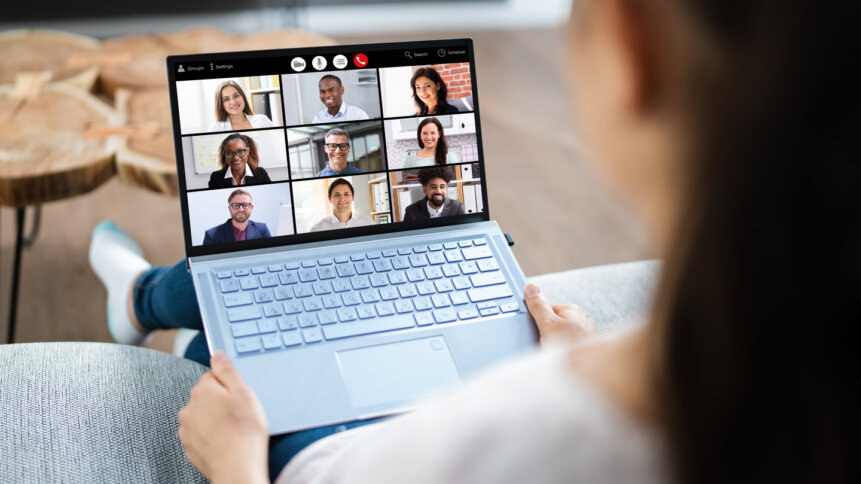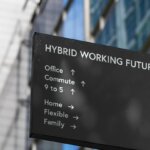What will hybrid working mean 10 years from now?

Hybrid working, meaning a mix of working remotely and working in the office, was – surprisingly, with hindsight – a significant novelty in the years before Covid-19.
It was a work model that was seen as neither one thing nor the other, and that didn’t usually fit well with strong, decisive business decision-making. Mixing remote and office-based work, where it was allowed at all, usually had to come attached to a strong and specific reason.
It was also often seen as a perk that came with a lowering of salary, to “compensate” companies for a worker’s absence from the office (where the work would normally be office-based), and to account for the lower overheads of largely remote workers on things like travel, daily food, and so on.
READ NEXT

What is hybrid working in 2023?
Perhaps the two biggest reasons why hybrid work was not a widespread thing before Covid though are 1) No-one was especially certain that the technologies required to facilitate it (such as video conferencing, remote collaboration tools and the like) could handle the transfer from being useful in a pinch to being essential all the time, and 2) There was no particular economic incentive for the whole business world to test out whether they could or not.
In the words of the old adage, “if it ain’t broke, don’t fix it.” Almost nobody in business regarded the system of near-universal in-office working as “broke,” so there was no incentive to see whether it could be “fixed.”
How it started.
Then the pandemic hit, the world of business rocked on its axis as real-world locations largely shut down, and suddenly there was a real economic incentive to “innovate or die.”
Many businesses were forced by government mandate to either go entirely remote or go out of business, with the understanding that the situation was temporary, and that “normal service” – meaning in-office work – would be resumed as soon as the world recovered from its viral apocalypse… assuming it ever did.
Remote working was the epitome of the flexible approach to work. If you legally couldn’t go into work, companies had no option but to offer a new work model, and to invest where necessary in the appropriate technology to make the new normal work.
Several things became apparent in those days. First, the pandemic had hit a world of work which, as far as offices were concerned, had the technological tools to continue from a distance.
Second, those tools would only get more and more refined as time went on, spurring a vast growth in the likes of cloud servers to allow remote workers to access company systems from anywhere.
And third, a combination of fear, loss, and tested technology would bring about a shift in the work-life balance paradigm, meaning hybrid working, when it took over from purely remote working, would not be shifted from the public consciousness as a perfectly normal way to get the job done.
Attempts have been made to reinstate full in-office working, but, as we’ve seen in the case of Twitter under Elon Musk, staff these days have plenty of options, and will be open to the idea of moving from even premium companies if the issue of hybrid working and a return to inflexibility is forced.
How it’s going.
But already, three years into the era of hybrid working, and mercifully past at least the initial fatal/virulent phase of Covid-19, what hybrid working means has radically shifted.
When it began, hybrid working meant business as usual, but geographically varied. The workday would still be 9-5 (or whatever variant of that pattern the company worked). Communication would be largely asynchronous (via email, for instance).
Trips into the office would largely mean a day spent doing the same work as was done at home. Use of collaboration tools and cloud-based company programs was relatively new, and a comparatively steep learning curve.
And, certainly at the start, hybrid workers were invasively monitored by some companies, to ensure they delivered their work to the in-office standards day after day while they adjusted to the new routines and disciplines of hybrid working.
Now, hybrid working, with its mixing of home work, remote work, and in-office work, has shifted from being a new and sometimes uncomfortable discipline to a genuine new normal.
Companies are finding the freedom that comes with being able to hire from a much wider geographical talent pool, and so are frequently offering roles as hybrid working from day one.
By this point, most office workers will have done at least one role on a hybrid basis, so the discipline it requires has been inculcated into them. That also means most businesses with any ethical bones will have largely abandoned invasive monitoring.
The standard 9-5 working pattern is beginning to dissipate, as hybrid workers do what needs to be done, both to meet (and exceed) the company’s requirements, and to enrich their own life experience with a healthier work-life balance.
The vast improvement of cloud services and video conferencing technology means everything from collaboration to communication with team members in the hybrid mix is already light years beyond what it was in the very early days of the first lockdowns.
Where it’s heading.
Hybrid working as a work model is not going away.
But where could it be going in terms of its evolution over the next decade?
Firstly, it seems likely that more and more businesses will reduce their physical footprint, because real estate is a big business expense that will grow less and less necessary the more hybrid working becomes normalized.
Secondly, the dissipation of geographically-centralized teams or businesses is likely to continue. Hybrid work makes it unnecessary to only recruit within a certain radius surrounding a physical HQ, and that’s likely to result in more geographical dissipation the better and faster connective technologies become.
9-5 RIP.
The traditional 9-5 work pattern, if it’s not quite dead yet, will be dead long before 2033. That’s likely, partly due to that geographical broadening of teams and businesses, and partly as a result of the enhanced work-life balance.
Allowing people to work more when they are at their most productive, be that 5am or 11pm, means you can actually get more productivity out of what is technically a smaller number of active hours, so there’s even significant credence given to the idea that hybrid working will lead to a “4-day week,” with no loss of productivity.
Such centralized office space as there is will likely be radically redesigned – the cubicle will largely be a dead concept within the next decade, because there’s no need to partition space for staff if they’re working remotely most of the time. Space will likely be reallocated into larger, more collaborative areas.
That will likely follow another trend – the “specialness” of time spent actually in the office space. Rather than an in-office day being business as usual, firstly, they are likely to be fewer and less regular than they have been up to now, and secondly, when they happen, they’re likely to be focused on collaborative, team-based work or discussions.
And as technology gets faster, and connectivity to online company assets and programs becomes a greater norm, the scope of what most roles will entail is likely to expand too, in directions that allow for greater personal and professional training and growth.
A much broader workforce.
An offshoot of that, already surfacing in Gen Z staff entering the hybrid working marketplace, will be significantly more opportunities for both upskilling and mental health, delivered as a corporate cultural norm via either self-learning courses or remote sessions with trainers and counsellors located around the country, or even around the world.
It’s even conceivable that a workplace culture more defined by a work-life balance skewed towards the home will open up significantly more than it did pre-pandemic. That would allow more women to return to work after pregnancy on a hybrid basis, for instance.
It would also help significantly broader ranges of staff – younger, older, people with physical disabilities, neurodiverent people, people across the spectrum of gender expression and so on – to make ongoing contributions which a strictly in-office culture denied them the opportunity to make in the years before the first lockdowns turned hybrid working into a new normality.
Hybrid working is here to stay. It’s an economic reality that signals a shift in the work-life balance post-Covid, and it’s already had profound effects on the way businesses work.
All the evidence suggests that a decade from now, those effects will only be more profound, radically changing the normality of working life into something that would have been inconceivable in the pre-pandemic years.









